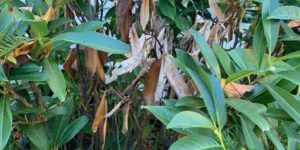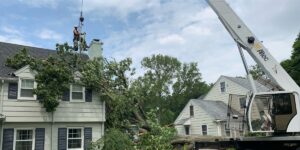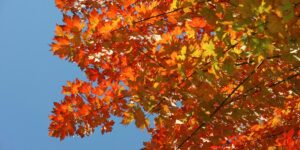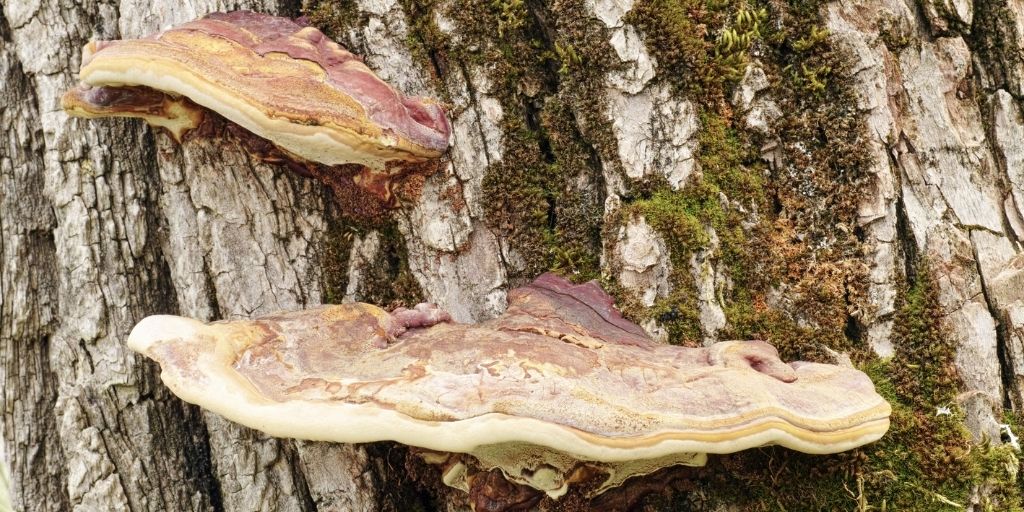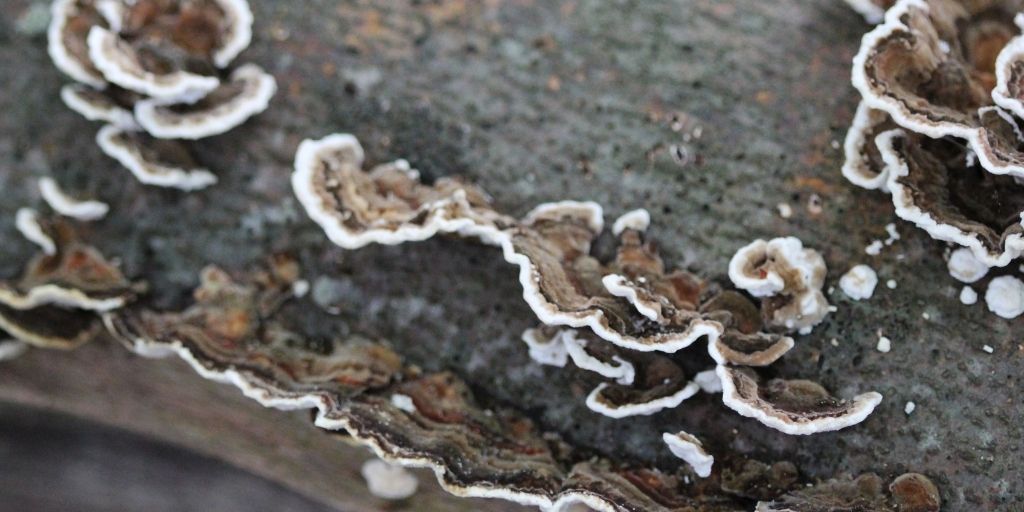Are you seeing mushrooms springing up around your tree? Conks or fungal growths on the trunk? Fungus near the tree base? If so, you’re probably wondering what’s going on and if will harm your trees.
Keep reading to find out:
- what these strange growths on your tree really are,
- whether fungi are bad for trees,
- the point at which fungal growths on trees become a serious problem, and
- what to do – and not do – if there are mushrooms, conks, or fungi on your trees.
Are those growths on your tree really mushrooms?
In New Jersey, you can find mushrooms growing on the trunk and branches of living trees, as well as around their base.
Although we often refer to them as mushrooms, these growths are more accurately called fungi. Scientists call many species of mushrooms that grow on trees by other names too, such as:
- conks,
- shelf fungi, or
- bracket fungi.
They’re often given those names because of the way they grow out horizontally from a tree’s trunk.
These fungi often don’t look like the mushrooms we eat on pizzas; they’re hard and tough, have no stems, and many of them are not edible.
What kinds of mushrooms grow on trees in New Jersey?
While there are over a million species of fungi, there are several that are most commonly found on New Jersey trees. We’re described them below.
Ganoderma species
The most common fungus in this species is Ganoderma applanatum. It’s called Artist’s Conk because you can draw on its smooth white underside.
Appearance – Ganoderma fungi are brown or gray, with a flat, shelf-like top and a white underside. They can grow up to three feet in size!
Location / Host Trees – You’ll find it growing on the trunk and at the base of trees. Its conks are most often seen growing on hardwood tree species, including:
- Beech (Fagus)
- Elm (Ulmus)
- Maple (Acer)
- Oak (Quercus)
What it does – This fungus causes wood rot in living trees.
Symptoms of Ganoderma include yellowing, wilting leaves, and branch dieback. These symptoms indicate that the fungus has weakened the tree’s internal structure. A decaying tree can fall over without warning, making it a hazard.
Trametes versicolor
Appearance – This bracket fungus is commonly called Turkey Tail because its ruffled edges and colors resemble turkey feathers.
Location / Host Trees – It’s found growing on New Jersey’s hardwood trees.
While the Turkey Tail fungus is most often associated with dead and fallen trees, it also grows on living trees when wounds provide openings for fungal spores to develop.
What it does – When this fungus enters a living tree, it causes internal rot that destroys a tree’s structural soundness.
Armillaria Root Rot Complex
Armillaria is commonly called “root rot.” It’s known as a “complex” because as many as six Armillaria fungal species are found together in affected trees.
Appearance – Armillaria fungi have stems and caps and grow in groups around the base of a tree. They are light golden brown with a white ring on their stem. While these fungi are smaller than conks, they can make large, overlapping groups of mushrooms.
Location / Host Trees – This fungal complex attacks many species of hardwood and coniferous trees; oaks and maples are among the most common.
You’ll find the fungi in late summer through fall, growing at the base of a tree and on the ground where a tree’s roots are.
What it does – As the name suggests, Armillaria causes root rot. Symptoms include:
- stunted leaf growth,
- chlorotic leaves,
- canopy dieback, and
- sap flow at the base of the tree.
The fungi kill young trees quickly. Older trees may grow for decades before showing symptoms of decay.
Fomes fomentarius
Appearance – This one is called “hoof fungus” because its shape resembles a horse hoof. It forms big brackets that are gray to black, with wavy edges.
Location / Host Trees – This fungus grows on a tree’s trunk. The most common tree species infected by hoof fungus are:
- Beech (Fagus)
- Maple (Acer)
- Birch (Betula)
- Oak (Quercus)
What it does – As with the Artist and Turkey Tail fungi, this fungus causes white rot in trees. This breaks down the tough lignin and makes wood soft and spongy, without strength.
Laetiporus sulphureus
Appearance – Known as “Chicken-of-the-woods,” Laetiporus suphureus is easily identified by its fan-shaped, bright yellow clusters.
Location / Host Trees – The bracket fungus grows on the trunks of both living and dead oak trees.
What it does – In living trees, the fungus causes brown rot in a tree’s heartwood.
Laetiporus cincinnatus
This close fungal relative to Laetiporus suplureus is also commonly called “Chicken-of-the-woods”. This one, however, causes root rot.
Appearance – It’s pale yellow or pink and forms a rosette shape instead of a shelf or bracket shape.
Location / Host Trees – You’ll find this conk growing at the base of a tree’s trunk or in the ground close to the trunk, where it grows from the tree’s roots.
As its common name suggests, “Chicken-of-the-woods” fungi are edible. However, we always caution people not to eat any mushrooms without positive identification and education about when and what parts of a mushroom to eat.
Every year people fall sick or die from eating foraged mushrooms. Always check before cooking or eating wild mushrooms!
Why do mushrooms grow on trees?
There’s no simple answer, but we can give you an idea how fungi end up growing on trees.
First, the fungus has to get onto the tree. There are several ways that can happen, such as:
- Mushrooms, or fungi, grow from spores. These are microscopic particles that are the fungal equivalent of seeds.
- Fungal spores are released from the gills or tubes of mature fungi. From there, they’re carried by wind, water, and animals to new hosts.
- Some fungi spread through the roots of trees. A tree’s extensive root system will often intertwine with the roots of nearby trees, making fungal transmission possible.
- Fungi can also enter trees through grafts, and when carried by insect pests.
When a fungal spore lands on a tree‘s trunk or branch, it then has to find a way in. If it finds a wound or opening in the tree’s bark, it will send its root-like filaments, called hyphae, into the tree. This is how the fungus will get energy to grow, and how it infects and decays wood tissue.
Are mushrooms on trees a bad sign?
Generally, yes.
Fungi are a vital part of nature, as they decompose decaying matter and cycle nutrients through soil for plants to use. But some fungi cause decay in living trees, and that’s when the problems arise.
These destructive fungi ultimately kill trees. They do so by:
- taking their energy reserves,
- plugging up a tree’s internal system that delivers water and nutrients to branches and leaves, and
- destroying the cells that give wood its strength and flexibility.
NOTE: By the time you find fungal conks growing on your tree’s trunk or at its base, it’s a sign that fungi have been at work for several years or more.
Signs That Fungi Have Damaged Your Trees
When you see mushrooms or conks growing on your tree’s trunk, at its base, or in the ground around a tree, it’s a sign that destructive fungi have grown and spread throughout the tree’s structure.
You may have noticed your trees looking unhealthy before you see mushrooms growing. Signs that your tree is affected by damaging fungi can include:
- general lack of vigor
- insect infestation
- leaf damage or dieback
- broken or dropped branches.
When a tree is already stressed, whether from drought, heat, or fungal decay, it is more susceptible to attack by insects and disease.
It may be impossible to tell which came first – fungal decay or other diseases and insect damage. But by the time you see mushrooms growing on your tree, it’s likely that your tree is declining and may be dangerous because of internal decay.
What To Do If You See Mushrooms or Conks On Your Trees
You may think that pulling or cutting off these from your tree will solve the problem. It won’t.
The mushrooms are a symptom of decay, not the cause. Removing them won’t kill the fungus that’s producing them.
The best scenario for your trees is to prevent fungal decay from starting. This means keeping your trees healthy right from the start.
Heat stress and water stress can make your tree vulnerable to destructive fungi (and other diseases), as can nutrient deficiencies.
Bad pruning cuts create openings for insects and diseases to attack your trees, so always have a qualified professional prune your trees. Make sure pruning is done at the right time of year and have your trees, especially large, mature trees, regularly inspected and evaluated.
Need a hand with your trees?
If you see mushrooms or conks growing on your trees, give us a call right away. A dying or decaying tree is a hazard because it can drop branches or fall over at any time, even if it looks OK from the outside.
No one likes losing a tree, but sometimes removing it before it causes damage is the only option.
Our trained arborists can examine your trees and evaluate the overall health of your garden. If any trees are at risk of developing fungal problems, we’ll let you know and recommend the best course of action. And if you’re looking for the best way to prevent mushrooms from damaging your trees, check out our comprehensive Tree Health Management services. We designed this program to keep your trees and landscape healthy year-round and would be happy to give you an estimate.


